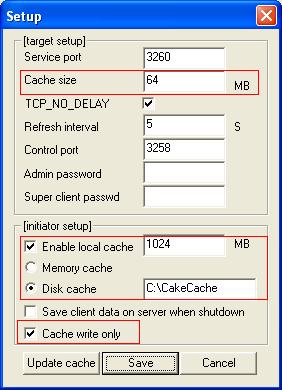|
1. What is iSCSI Cake(CCDisk)?
iSCSI Cake is a storage server which exports a server's storage resources
to clients. The clients can access an iSCSI disk as a local hard
disk. The iSCSI disk supports all normal disk operations including
read, write, format and partition.
2. What is the difference between iSCSI Cake (CCDisk) and
other iSCSI targets?
iSCSI Cake is the first iSCSI target to support VMWare file disk. VMDK
file can be exported to clients as local disk which provides users
another storage virtualization solution.
3. What are the other notable features of iSCSI Cake (CCDisk)?
Server's data is protected by copy-on-write mechanism. Client's write
requests are redirected to working directory without modifying server's
data.
4. What is the difference between iSCSI Cake (CCDisk) and
SMB?
SMB protocol shares data at the file system level while iSCSI shares
data at the block level. Mapped network drives do not support applications
such as databases which require local drives and games while iSCSI
Cake has no such limitation. iSCSI Cake supports storage sharing
through WAN while SMB can only be used within LAN.
5. Who needs iSCSI Cake (CCDisk)?
System administrators in enterprise storage center, internet Cafes. They
will no longer need to install software on every client computer
using iSCSI Cake. And they do not need to worry about data safety
any more.
6. Can iSCSI Cake (CCDisk) work alone?
No. iSCSI Cake is only a server application. It works with iSCSI
client (Initiator). iSCSI Cake supports nearly all iSCSI initiators
on Windows/Linux/Solaris platform. The free Microsoft Initiator
2 is highly recommended and can be found at the following URL: MS
iSCSI Inititor
7. How can I save my data on server?
Only super client can change server's data. First, you need to enable
super client in disk property. Second, a password (12-15 characters)
must be setup in setup panel. Third, client must log on server with
CHAP. The icon for super client is different in client list view.
8. How many LUNs does iSCSI Cake (CCDisk) support?
Current version supports up to 16 LUNs per client. However, user
can assign different disk to different client.
9. How can I connect iSCSI Cake (CCDisk) server through port forwarding?
You can change the server IP in iSCSICake.ini to the address your
initiator can see and restart service. For example, iSCSI Cake server's
LAN address is 192.168.0.1, and the WAN address of router is 72.87.118.226.
In this case, the server IP in iSCSICake.ini should be changed to
72.87.118.226.
10. How to boot Win2003 with iSCSI Cake?
We have another product CCBoot. It supports boot Windows with iSCSI. For more information, please refer to this article: http://www.ccboot.com/download/ccboot.pdf
11. Instructions for iSCSI Cake cache.
There are two types of cache: server cache ("Cache size" under "Target setup") and client cache (cache under "Initiator setup").

Server cache - it is cache on iSCSI Cake server. iSCSI Cake will allocate an area from system memory for this cache. BTW, This cache is only for client reading.
Client cache - This is cache on the client, and it can be used for both read and write cache. To use this feature, you need to first install MS iSCSI Initiator, then install iSCSI Cake Client on the client computers.
Enable local cache - Only after you have installed iSCSI Cake Client, this option will be available. It's used for specifying the cache size on client. Then you need to select use "Memory cache" or "Disk cache".
Memory cache - If you select the "Memory cache", iSCSI Cake Client will allocate an area from system memory for this client cache.
Disk cache - If you select the "Disk cache", iSCSI Cake Client will create an folder as you specified (like C:\CakeCache) on the hard disk for this client cache.
Cache write only - If you select the "Cache write only", this client cache will be used for only write. If you do not select this option, this client cache will be used for both read and write.
|